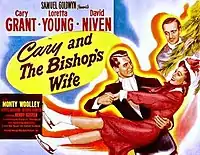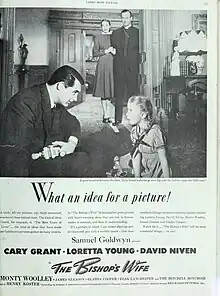The Bishop's Wife
The Bishop's Wife (also known as Cary and the Bishop's Wife)[5] is a 1947 American supernatural romantic comedy film directed by Henry Koster and starring Cary Grant, Loretta Young, and David Niven. The plot is about an angel who helps a bishop with his problems. The film was adapted by Leonardo Bercovici and Robert E. Sherwood from the 1928 novel of the same name by Robert Nathan.
| The Bishop's Wife | |
|---|---|
.jpg.webp) Theatrical release poster by William Rose | |
| Directed by | Henry Koster |
| Screenplay by |
|
| Based on | The Bishop's Wife 1928 novella by Robert Nathan |
| Produced by | Samuel Goldwyn |
| Starring | |
| Cinematography | Gregg Toland |
| Edited by | Monica Collingwood |
| Music by | Hugo Friedhofer |
Production company | |
| Distributed by | RKO Radio Pictures |
Release dates | |
Running time | 109 minutes[lower-alpha 1] |
| Country | United States |
| Language | English |
| Box office | $3 million (US rentals)[4] |
It was remade in 1996 as The Preacher's Wife starring Denzel Washington, Whitney Houston, and Courtney B. Vance.
Plot
Bishop Henry Brougham (David Niven), troubled with funding the building of a new cathedral, prays for divine guidance. His plea is seemingly answered by a suave angel named Dudley (Cary Grant), who reveals his identity only to the clergyman.
However, Dudley's mission is not to help construct a cathedral, but to spiritually guide Henry and the people around him. Henry has become obsessed with raising funds, to the detriment of his family life. His relationships with wife Julia (Loretta Young) and their young daughter Debby (Karolyn Grimes) are strained by his focus on the cathedral.
Everyone, except for Henry, is charmed by Dudley, even the non-religious Professor Wutheridge (Monty Woolley). When Dudley spends time cheering up Julia, though, an unexpected development occurs: he finds himself strongly attracted to her. Sensing this, Henry becomes jealous and anxious for his now unwelcome guest to finish and depart. He reveals Dudley's true identity to Professor Wutheridge, who urges him to stand up and fight for the woman he loves.
Dudley persuades a wealthy parishioner, the widowed Agnes Hamilton (Gladys Cooper), to contribute her much needed funds, but not to build the cathedral as Henry had hoped. Instead, he coaxes Mrs. Hamilton to donate her money to feed and clothe the needy, much to Henry's chagrin.
On several occasions throughout the film, Dudley reveals himself to viewers as an angel. He helps Julia and Sylvester (a taxi driver) ice skate like pros, redecorates the Broughams' Christmas tree in a few seconds, saves an old church by restoring interest in the boys' choir, dictates to a typewriter to magically produce Henry's new sermon—without Henry's knowledge—among other small things.
As the climax to the movie approaches, Dudley hints to Julia his willingness to stay with her and not move on to his next assignment. Although Julia doesn't fully understand what he's talking about, she senses what he means, and tells him it is time for him to leave. Dudley tells the bishop it is rare for an angel to envy a mortal. When Henry wants to know why his cathedral plans were derailed, Dudley reminds the Bishop that he had prayed for guidance, not a building.
With his mission completed and knowing that Julia loves her husband, Dudley leaves, promising never to return. All memory of him is erased, and later that Christmas Eve at midnight, Henry delivers the sermon he believes he has written. Dudley observes from the street, satisfied that his work is done.
Cast
- Cary Grant as Dudley
- Loretta Young as Julia Brougham
- David Niven as Bishop Henry Brougham
- Monty Woolley as Professor Wutheridge
- James Gleason as Sylvester, a sympathetic taxi driver
- Gladys Cooper as Mrs. Agnes Hamilton
- Elsa Lanchester as Matilda, the Broughams' housekeeper
- Sara Haden as Mildred Cassaway, the Bishop's secretary
- Karolyn Grimes as Debby Brougham, the Broughams' daughter
- Tito Vuolo as Maggenti
- Regis Toomey as Reverend Miller (credited as Mr. Miller)
- Sarah Edwards as Mrs. Duffy
- Margaret McWade as Miss Trumbull
- Anne O'Neal as Mrs. Ward
- Ben Erway as Mr. Perry
- Erville Alderson as Stevens
- Robert J. Anderson as Defence Captain
- Teddy Infuhr as Attack Captain
- Eugene Borden as Michel
- Almira Sessions as First Lady in Michel's
- Claire Du Brey as Second Lady (as Claire DuBrey)
- Florence Auer as Third Lady
- Margaret Wells as Hat Shop Proprietress
- Kitty O'Neil as Hat Shop Customer (as Kitty O'Neill)
- Isabel Jewell as Hysterical Mother
- David Leonard as Blind Man
- Dorothy Vaughan as Delia
- Edgar Dearing as Policeman
- The Robert Mitchell Boys Choir as Vocal Ensemble (as The Mitchell Boychoir)
Niven was originally cast as the angel, Dana Andrews as the bishop, and Teresa Wright as his wife. However, Wright had to bow out due to pregnancy. According to Robert Osborne, Andrews was lent to RKO in order to obtain Loretta Young. Koster then brought in Cary Grant, but he wanted to play the angel, so the role of the bishop was given to Niven.
Production



Production faced a few difficulties. Producer Samuel Goldwyn replaced director William A. Seiter with Henry Koster to create a completely new film. In early previews, audiences disliked the film, so Billy Wilder and Charles Brackett made uncredited rewrites. Even so, and even though the premiere of The Bishop's Wife was accompanied by critical success, the film did not initially perform well at the box office. Market research showed that moviegoers avoided the film because they thought it was religious. As a result, Goldwyn decided to retitle it Cary and the Bishop's Wife for certain US markets, while adding a black text box with the question "Have you heard about CARY AND THE BISHOP'S WIFE?" on posters in markets where the film kept the original title. By adding Grant's first name to the title, the film's business increased by as much as 25 percent.[5][6]
Location filming was in Minneapolis, Minnesota.[7] In the scene in which Dudley conducts the boys' choir, the Charles Gounod composition 'Noël: Montez à Dieu' ('O Sing to God') was performed by the Robert Mitchell Boys Choir.[8] Emil Newman and Herbert W. Spencer's melody, "Lost April," was given lyrics by Eddie DeLange and recorded by Nat King Cole.
Reception
On the review aggregator website Rotten Tomatoes, The Bishop's Wife holds an approval rating of 84% based on 25 reviews. The website's critical consensus reads, "The Bishop's Wife succeeds thanks to the strength of winning performances from a stellar cast, which includes Cary Grant and Loretta Young."[9]
Awards and nominations
| Award | Category | Nominee(s) | Result | Ref. |
|---|---|---|---|---|
| Academy Awards | Best Motion Picture | Samuel Goldwyn (for RKO Radio Pictures) | Nominated | [10] |
| Best Director | Henry Koster | Nominated | ||
| Best Film Editing | Monica Collingwood | Nominated | ||
| Best Scoring of a Dramatic or Comedy Picture | Hugo Friedhofer | Nominated | ||
| Best Sound Recording | Gordon E. Sawyer | Won |
The film is recognized by American Film Institute in these lists:
- 2002: AFI's 100 Years...100 Passions – Nominated[11]
- 2006: AFI's 100 Years...100 Cheers – Nominated[12]
Adaptations to other media
The Bishop's Wife was dramatized as a half-hour radio play on the March 1, 1948, broadcast of The Screen Guild Theater with Cary Grant, Loretta Young and David Niven in their original film roles. It was also presented on Lux Radio Theater three times as an hour-long broadcast: first on December 19, 1949, with Tyrone Power and David Niven, second on May 11, 1953, with Cary Grant and Phyllis Thaxter and third on March 1, 1955, again with Grant and Thaxter.[13]
The soundtrack has been released on compact disc.[14]
The 1996 film The Preacher's Wife was a remake based on The Bishop's Wife.
Note
- 2013 release of Blu-lay from Warner Home Video is slightly cut.[2][3]
References
- "The Bishop's Wife: Detail View". AFI Catalog of Feature Films. Retrieved November 18, 2022.
- ""NOT a complete print!! Missing key musical footage!"". Amazon.at amazon.com review
- ""Great movie, but terrible blu ray transfer!!!!!!!!!!!!!!!". Amazon.at amazon.com review
- "Top Grossers of 1948". Variety. January 5, 1949. p. 46.
- Martin, Pete (February 19, 1949). "How Grant Took Hollywood". The Saturday Evening Post. p. 22. Retrieved December 5, 2021 – via GaryGrant.net.
- Dans, Peter E. (May 16, 2009). Christians in the Movies: A Century of Saints and Sinners. Rowman & Littlefield. p. 93. ISBN 978-0-7425-7032-0. Retrieved December 5, 2021.
- Filming locations for The Bishop's Wife at IMDb
- Boys' Choir scene from The Bishop's Wife on YouTube
- "The Bishop's Wife". Rotten Tomatoes. Retrieved October 7, 2021.
- "The 20th Academy Awards (1948) Nominees and Winners". Oscars.org. Retrieved August 18, 2011.
- "AFI's 100 Years...100 Passions Nominees" (PDF). Retrieved August 18, 2016.
- "AFI's 100 Years...100 Cheers Nominees" (PDF). Retrieved August 18, 2016.
- Kirby, Walter (May 10, 1953). "Better Radio Programs for the Week". The Decatur Daily Review. p. 50. Retrieved June 27, 2015 – via Newspapers.com.
- "The Bishop's Wife (1947)". SoundtrackInfo. Retrieved October 10, 2009.
External links
- The Bishop's Wife at IMDb
- The Bishop's Wife at AllMovie
- The Bishop's Wife at the American Film Institute Catalog
- The Bishop's Wife at the TCM Movie Database
Streaming audio
- The Bishop's Wife on Screen Guild Theater: March 1, 1948
- The Bishop's Wife on Lux Radio Theater: May 11, 1953